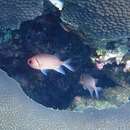Diagnostic Description
provided by Fishbase
Body light red to yellowish; fins red, leading edges of soft dorsal, anal, caudal and pelvic fins white (Ref. 4201).Description: Characterized by lower two-thirds of axil of pectoral fins with small scales; front of lower jaw with two pairs of tooth patches outside gape; depth of body 2.1-2.5 in SL (Ref. 90102).
- Recorder
- Cristina V. Garilao
Morphology
provided by Fishbase
Dorsal spines (total): 11; Dorsal soft rays (total): 13 - 15; Analspines: 4; Analsoft rays: 11 - 14
- Recorder
- Cristina V. Garilao
Trophic Strategy
provided by Fishbase
Inhabits sheltered coastal and offshore reefs, usually in turbid areas of bays and lagoons, in 3-40 m (Ref 90102). A nocturnal fish hiding in caves or beneath ledges by day, feeding on plankton such as crab larvae at night. Found in loose aggregations in caves, sometimes with other soldierfish (Ref. 9710, 12419).
- Recorder
- Drina Sta. Iglesia
Biology
provided by Fishbase
Inhabits sheltered coastal and offshore reefs, usually in turbid areas of bays and lagoons, in 3-40 m (Ref 90102). A nocturnal fish hiding in caves or beneath ledges by day, feeding on plankton such as crab larvae at night. Found in loose aggregations in caves, sometimes with other soldierfish (Ref. 9710).
- Recorder
- Estelita Emily Capuli
Importance
provided by Fishbase
fisheries: minor commercial; price category: medium; price reliability: very questionable: based on ex-vessel price for species in this family
- Recorder
- Estelita Emily Capuli
Myripristis hexagona
provided by wikipedia EN
Myripristis hexagona, the doubletooth soldierfish, is a nocturnal species of soldierfish from the genus Myripristis. It is light red to yellowish in colour, and grows to a maximum length of 30 cm (11.8 in). It can be found in the Indo-Pacific region, from East Africa to Samoa, north to the Ryukyu Islands, Japan, and south to the Great Barrier Reef and New Caledonia. However, it has not been found on low islands or atolls in the Indo-Pacific region.[2] It is found at depths of 3–40 metres (9.8–131.2 ft) and inhabits sheltered coastal and offshore reefs, typically in turbid areas of bays or lagoons. During the day, it hides in caves or beneath ledges, while at night, it feeds on plankton. It can be found in loose aggregations, sometimes with other species of soldierfish.[3]
References

- license
- cc-by-sa-3.0
- copyright
- Wikipedia authors and editors
Myripristis hexagona: Brief Summary
provided by wikipedia EN
Myripristis hexagona, the doubletooth soldierfish, is a nocturnal species of soldierfish from the genus Myripristis. It is light red to yellowish in colour, and grows to a maximum length of 30 cm (11.8 in). It can be found in the Indo-Pacific region, from East Africa to Samoa, north to the Ryukyu Islands, Japan, and south to the Great Barrier Reef and New Caledonia. However, it has not been found on low islands or atolls in the Indo-Pacific region. It is found at depths of 3–40 metres (9.8–131.2 ft) and inhabits sheltered coastal and offshore reefs, typically in turbid areas of bays or lagoons. During the day, it hides in caves or beneath ledges, while at night, it feeds on plankton. It can be found in loose aggregations, sometimes with other species of soldierfish.
- license
- cc-by-sa-3.0
- copyright
- Wikipedia authors and editors
Description
provided by World Register of Marine Species
A nocturnal fish hiding in caves or beneath ledges by day, feeding on plankton such as crab larvae at night. Occurs at 40 m depth. Found in loose aggregations in caves, sometimes with other soldierfish (Ref. 9710).
Froese, R. & D. Pauly (Editors). (2023). FishBase. World Wide Web electronic publication. version (02/2023).
- license
- cc-by-4.0
- copyright
- WoRMS Editorial Board

